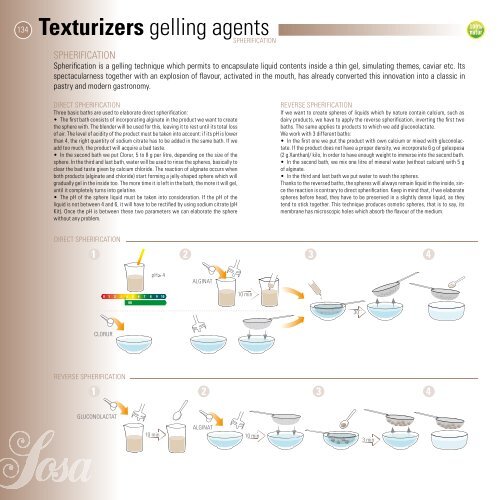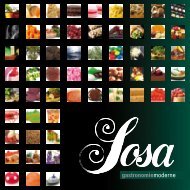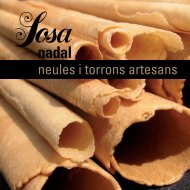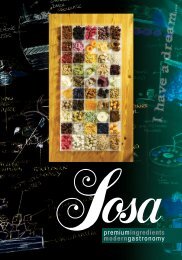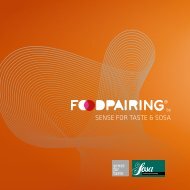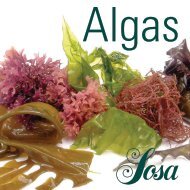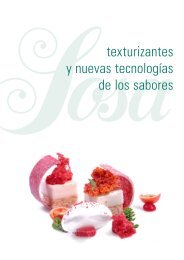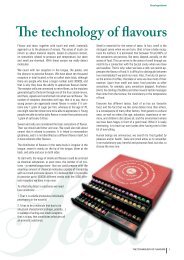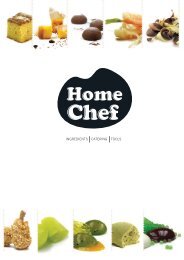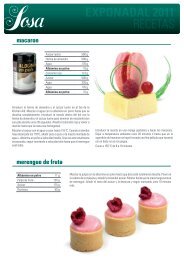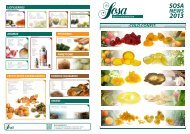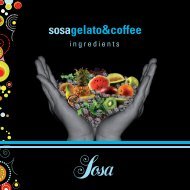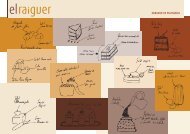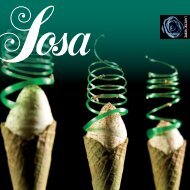Essence of - Sosa
Essence of - Sosa
Essence of - Sosa
Create successful ePaper yourself
Turn your PDF publications into a flip-book with our unique Google optimized e-Paper software.
134 Texturizers gelling agents<br />
SPHERIFICATION<br />
SPHERIFICATION<br />
Spherification is a gelling technique which permits to encapsulate liquid contents inside a thin gel, simulating themes, caviar etc. Its<br />
spectacularness together with an explosion <strong>of</strong> flavour, activated in the mouth, has already converted this innovation into a classic in<br />
pastry and modern gastronomy.<br />
DIRECT SPHERIFICATION<br />
Three basic baths are used to elaborate direct spherification:<br />
• The first bath consists <strong>of</strong> incorporating alginate in the product we want to create<br />
the sphere with. The blender will be used for this, leaving it to rest until its total loss<br />
<strong>of</strong> air. The level <strong>of</strong> acidity <strong>of</strong> the product must be taken into account: if its pH is lower<br />
than 4, the right quantity <strong>of</strong> sodium citrate has to be added in the same bath. If we<br />
add too much, the product will acquire a bad taste.<br />
• In the second bath we put Clorur, 5 to 8 g per litre, depending on the size <strong>of</strong> the<br />
sphere. In the third and last bath, water will be used to rinse the spheres, basically to<br />
clear the bad taste given by calcium chloride. The reaction <strong>of</strong> alginate occurs when<br />
both products (alginate and chloride) start forming a jelly-shaped sphere which will<br />
gradually gel in the inside too. The more time it is left in the bath, the more it will gel,<br />
until it completely turns into gelatine.<br />
• The pH <strong>of</strong> the sphere liquid must be taken into consideration. If the pH <strong>of</strong> the<br />
liquid is not between 4 and 6, it will have to be rectified by using sodium citrate (pH<br />
Kit). Once the pH is between these two parameters we can elaborate the sphere<br />
without any problem.<br />
REVERSE SPHERIFICATION<br />
If we want to create spheres <strong>of</strong> liquids which by nature contain calcium, such as<br />
dairy products, we have to apply the reverse spherification, inverting the first two<br />
baths. The same applies to products to which we add gluconolactate.<br />
We work with 3 different baths:<br />
• In the first one we put the product with own calcium or mixed with gluconolactate.<br />
If the product does not have a proper density, we incorporate 6 g <strong>of</strong> gelespesa<br />
(2 g Xanthan)/ kilo, In order to have enough weight to immerse into the second bath.<br />
• In the second bath, we mix one litre <strong>of</strong> mineral water (without calcium) with 5 g<br />
<strong>of</strong> alginate.<br />
• In the third and last bath we put water to wash the spheres.<br />
Thanks to the reversed baths, the spheres will always remain liquid in the inside, since<br />
the reaction is contrary to direct spherification. Keep in mind that, if we elaborate<br />
spheres before head, they have to be preserved in a slightly dense liquid, as they<br />
tend to stick together. This technique produces osmotic spheres, that is to say, its<br />
membrane has microscopic holes which absorb the flavour <strong>of</strong> the medium.<br />
DIRECT SPHERIFICATION<br />
1<br />
2<br />
3<br />
4<br />
pH≥ 4<br />
ALGINAT<br />
0 1 2 3 4 5 6 7 8 9 10<br />
OK<br />
10 min<br />
30’’<br />
CLORUR<br />
REVERSE SPHERIFICATION<br />
1<br />
2<br />
3<br />
4<br />
GLUCONOLACTAT<br />
ALGINAT<br />
10 min 10 min<br />
3 min


